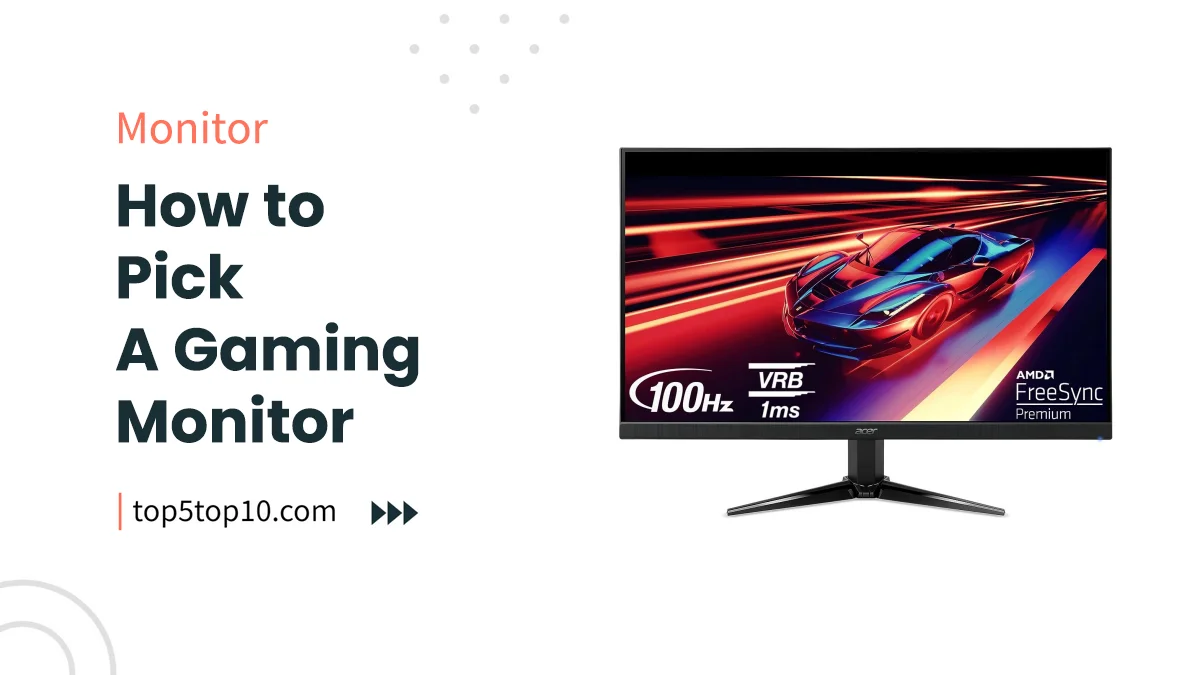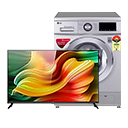
How to Pick a Gaming Monitor – When it comes to enhancing your gaming experience, selecting the right gaming monitor can be just as crucial as having a powerful gaming PC or console.
A gaming monitor not only impacts the visual quality of your games but also affects your overall gaming performance.
In this comprehensive guide, we’ll walk you through the key factors to consider when choosing the perfect gaming monitor that suits your gaming preferences, budget, and needs.
Contents
- 1. Understanding Gaming Monitor Basics
- 2. Budget and Cost Considerations for a Gaming Monitor
- 3. Panel Technology and Viewing Angles for a Gaming Monitor
- 4. Refresh Rate and Response Time for a Gaming Monitor
- 5. Resolution and Visual Quality for a Gaming Monitor
- 6. Adaptive Sync Technologies for a Gaming Monitor
- 7. Size and Aspect Ratio for a Gaming Monitor
- 8. Additional Features and Connectivity for a Gaming Monitor
- 9. Reading Reviews and Gathering Feedback for a Gaming Monitor
- 10. Making Your Selection for a Gaming Monitor
- Conclusion
- 5 Best Gaming Monitor Brands
- 10 Best Gaming Monitor Accessories List 2023
- How to Pick a Gaming Monitor FAQs
1. Understanding Gaming Monitor Basics
Before diving into the intricacies of choosing a gaming monitor, let’s start with the basics.
1.1 Different Types of Gaming Monitors
Gaming monitors come in various types, each with its unique characteristics. The most common types include:
| TN Gaming Monitor | IPS Gaming Monitor | IPS Gaming Monitor |
|---|---|---|
| Known for fast response times and high refresh rates but with limited viewing angles and color accuracy. | Offers better color accuracy and wider viewing angles but may have slightly slower response times. | Known for vibrant colors, deep blacks, and quick response times but often comes with a higher price tag. |
Recent Posts
- Polk vs Sony Soundbars: Making the Right Choice
- Sonos vs Polk Soundbars: A Comprehensive Comparison
- Polk vs JBL Soundbars: A Comprehensive Comparison
- Polk vs Bose Soundbars: A Comprehensive Comparison
1.2 Consider Your Gaming Preferences
When choosing a gaming monitor, consider your gaming preferences:
1. Type of Games You Play
Different types of games may benefit from specific monitor features. For example:
- FPS (First-Person Shooter) gamers may prioritize high refresh rates for smoother aiming and movement.
- RPG (Role-Playing Game) enthusiasts may focus on visual quality and immersive experiences.
- Racing game fans may prefer ultrawide monitors for a wider field of view.
2. Competitive Gaming vs Casual Gaming
Your level of competitiveness affects your choice of monitor:
- Competitive gamers benefit from high refresh rates and low response times for precise actions.
- Casual gamers may prioritize visual quality and comfort over ultra-fast performance.
3. Single-Player vs Multiplayer Experiences
Consider whether you primarily enjoy single-player campaigns or multiplayer matches. For multiplayer, responsive performance may be crucial.
4. Desired Visual Quality
Determine your desired graphics settings and whether you prefer higher frame rates or better visual fidelity.
2. Budget and Cost Considerations for a Gaming Monitor
Setting a budget is essential when choosing a gaming monitor. Fortunately, there are options to fit various price ranges.
| Budget Range | Gaming Monitor | Features |
|---|---|---|
| Gaming Monitor Below $200 (around ₹15,000) | Basic gaming monitors with 60Hz-75Hz refresh rates and Full HD resolution. | |
| Gaming Monitor $200-$400 (around ₹15,000-30,000) | Mid-range monitors with 144Hz refresh rates, adaptive sync, and various panel types. | |
| Gaming Monitor $400-$800 (around ₹30,000-60,000) | High-end monitors with 144Hz-240Hz refresh rates, higher resolutions, and advanced features. | |
| Gaming Monitor $800+ (around ₹60,000+) | Premium monitors with OLED panels, 4K resolution, and cutting-edge technology. |
When considering your budget, aim for a monitor that strikes a balance between performance and affordability based on your gaming needs.
3. Panel Technology and Viewing Angles for a Gaming Monitor
The type of panel technology impacts color accuracy and viewing angles:
| Panel Type | Characteristics |
|---|---|
| TN (Twisted Nematic) Gaming Monitor | Fast response times but limited viewing angles and color accuracy. |
| IPS (In-Plane Switching) Gaming Monitor | Better color accuracy and wider viewing angles but slightly slower response times. |
| OLED (Organic Light-Emitting Diode) Gaming Monitor | Vibrant colors, deep blacks, and quick response times but often more expensive. |
Select a panel type that aligns with your gaming and content consumption preferences. For competitive gaming, TN panels may suffice, while IPS or OLED panels are better for immersive experiences.
4. Refresh Rate and Response Time for a Gaming Monitor
The refresh rate and response time significantly impact your gaming experience:
Refresh Rate
- A higher refresh rate leads to smoother gameplay.
- 60Hz is the standard, 144Hz provides noticeable improvement, and 240Hz is ideal for competitive gaming.
Response Time
- Lower response times reduce motion blur and ghosting effects.
- A response time of 1ms is ideal for fast-paced gaming.
To achieve smooth and responsive gameplay, choose a monitor with a refresh rate that matches your gaming style and a low response time.
5. Resolution and Visual Quality for a Gaming Monitor
Resolution affects the clarity and detail of your gaming visuals:
Resolution Options
- Full HD (1920×1080) is standard and suitable for most gamers.
- 4K (3840×2160) offers incredible sharpness but demands a powerful GPU.
- Ultrawide monitors provide immersive experiences with wider aspect ratios.
Select a resolution that aligns with your graphics card’s capabilities and the visual quality you desire.
6. Adaptive Sync Technologies for a Gaming Monitor
Adaptive Sync technologies, such as G-Sync and FreeSync, reduce screen tearing and stuttering:
G-Sync
- Developed by NVIDIA.
- Compatible with NVIDIA GPUs.
- Ensures smoother gameplay by synchronizing the monitor’s refresh rate with the GPU’s frame rate.
FreeSync
- Developed by AMD.
- Compatible with AMD GPUs.
- Provides a similar benefit as G-Sync for AMD graphics card users.
Choose a monitor with the appropriate adaptive sync technology based on your GPU brand.
7. Size and Aspect Ratio for a Gaming Monitor
Consider the panel size and aspect ratio to fit your gaming environment:
Panel Size
- 24-27 inches is the standard size suitable for most gaming setups.
- Larger sizes (32+ inches) provide an immersive experience.
Aspect Ratio
- 16:9 is the standard aspect ratio.
- Ultrawide monitors (21:9 or 32:9) offer a wider field of view for enhanced immersion.
Select the panel size and aspect ratio that complement your gaming setup and available space.
8. Additional Features and Connectivity for a Gaming Monitor
Look for additional features and connectivity options that enhance your gaming experience:
Built-in Speakers
- Evaluate the audio quality if you prefer not to use external speakers or headphones.
Ergonomic Design
- Adjustable stands and ergonomic design ensure comfortable gaming sessions.
Connectivity
- Check for HDMI, DisplayPort, and USB ports to connect various devices.
- Consider additional features like RGB lighting and aesthetics to personalize your setup.
9. Reading Reviews and Gathering Feedback for a Gaming Monitor
Before making a final decision, read expert reviews and gather feedback from the gaming community:
- Expert reviews offer insights into a monitor’s performance, features, and value for money.
- User reviews provide real-world experiences and potential issues.
- Forums and gaming communities offer valuable discussions and recommendations.
10. Making Your Selection for a Gaming Monitor
Narrow down your options based on your preferences and budget:
- Prioritize essential features that align with your gaming style and needs.
- Consider user feedback and expert reviews to make an informed decision.
- Purchase a gaming monitor that enhances your gaming experience and brings your favorite games to life.
Conclusion
Selecting the right gaming monitor is a critical step in optimizing your gaming setup.
By understanding the basics of gaming monitor technology, considering your gaming preferences, budgeting wisely, and evaluating critical features, you can find the perfect monitor to elevate your gaming experience.
Whether you’re a competitive gamer or simply looking to enjoy immersive visuals, the right gaming monitor can make all the difference in your gaming world. Happy gaming!
Disclaimer: Prices and ratings mentioned in this article are approximate and subject to change. Be sure to check the latest prices and reviews before making a purchase.
5 Best Gaming Monitor Brands
| Gaming Monitor Brands | Best Price in India |
|---|---|
| LG Gaming Monitor | Buy on Amazon |
| Samsung Gaming Monitor | Buy on Amazon |
| ASUS Gaming Monitor | Buy on Amazon |
| Acer Gaming Monitor | Buy on Amazon |
| Dell Gaming Monitor | Buy on Amazon |
10 Best Gaming Monitor Accessories List 2023
| # | Preview | Product | Rating | Price | |
|---|---|---|---|---|---|
| 1 |

|
WILLED Under Monitor Light Bar, RGB Gaming Lights for... | 941 Reviews | ₹ 3,781 | Buy on Amazon |
| 2 |

|
HEYMIX LIFE Single Monitor Arm,Single Monitor Stand... | 75 Reviews | ₹ 4,449 ₹ 2,199 | Buy on Amazon |
| 3 |

|
UPORT 10 Meter 4K HDMI Cable High Speed, Gold... | 195 Reviews | ₹ 2,599 ₹ 999 | Buy on Amazon |
| 4 |

|
Flip The Bottle Game | 11 Reviews | Buy on Amazon | |
| 5 |

|
Ant Esports GS370SB Gaming Computer Speakers for PC... | 1,579 Reviews | ₹ 1,899 ₹ 1,149 | Buy on Amazon |
| 6 |

|
RIATECH 3mm Thickness Extra Large Size (900x400mm)... | 11,125 Reviews | ₹ 2,499 ₹ 469 | Buy on Amazon |
| 7 |

|
HOW TO BUILD MY GAMING PC : The Ultimate Step By Step... | 1 Reviews | ₹ 327 | Buy on Amazon |
| 8 |

|
HOW TO BUILD A CORRECT GAMMING PC: An Essential Guide... | 1 Reviews | ₹ 413 | Buy on Amazon |
| 9 |

|
Toppings Monitor Cover Compatible with Samsung... | ₹ 799 ₹ 349 | Buy on Amazon | |
| 10 |

|
Amazon Basics 2 X 3W Multimedia PC Gaming Speaker with... | ₹ 1,999 ₹ 611 | Buy on Amazon |
How to Pick a Gaming Monitor FAQs
When selecting a gaming monitor, you should consider several key factors. These include the monitor's panel technology (e.g., IPS, TN, OLED), refresh rate (measured in Hz), response time (measured in milliseconds), resolution (e.g., Full HD, 4K), adaptive sync technology (e.g., G-Sync or FreeSync), size and aspect ratio, and additional features like HDR support and connectivity options.
Yes, the panel technology of a gaming monitor matters. Different panel types have varying characteristics. For example, IPS panels offer excellent color accuracy and wide viewing angles but may have slightly slower response times. TN panels provide faster response times but narrower viewing angles. OLED panels deliver vibrant colors and fast response times but can be costly. The choice depends on your priorities for gaming.
Refresh rate and response time are critical factors for gaming monitors. The refresh rate, measured in Hz, determines how many frames per second the monitor can display. A higher refresh rate (e.g., 144Hz or 240Hz) results in smoother gameplay. Response time, measured in milliseconds, affects how quickly pixels change colors. Lower response times reduce motion blur and ghosting effects, crucial for fast-paced games.
The choice between higher resolution and faster refresh rate depends on your gaming preferences. Higher resolution (e.g., 4K) delivers sharper visuals but may require a powerful GPU. Faster refresh rates (e.g., 144Hz or 240Hz) offer smoother gameplay and are ideal for competitive gaming. Consider your GPU capabilities and the types of games you play to make the decision.
Yes, adaptive sync technology is valuable for gaming monitors. Technologies like G-Sync (NVIDIA) and FreeSync (AMD) help prevent screen tearing and stuttering by synchronizing the monitor's refresh rate with the GPU's frame output. This results in a smoother and tear-free gaming experience. Make sure your graphics card supports the corresponding technology when choosing a monitor. What factors should I consider when choosing a gaming monitor?
Does the monitor's panel technology matter for gaming?
What is the significance of refresh rate and response time in gaming monitors?
Should I prioritize higher resolution or faster refresh rate for gaming?
Is adaptive sync technology important for gaming monitors?
|
Related Tags
How to pick a gaming monitor ps5, How to pick a gaming monitor for gaming, what to look for in a gaming monitor for ps5, how to choose a monitor for gaming reddit, 4k gaming monitor, best gaming monitor 2023, how to choose a monitor for home office, how to choose monitor for laptop
Last update on 2024-05-19 at 03:46 / Affiliate links / Images from Amazon Product Advertising API












